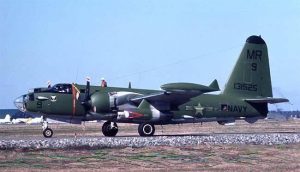
During the Vietnam war, the Viet Cong and the North Vietnamese Army moved massive amounts of munitions by truck and troops down the Ho Chi Minh Trail. The route was the most heavily defended area of Viet Nam. Radar controlled anti-aircraft guns surrounded the Trail and moved daily to avoid detection. Secretary of Defense, Robert McNamara, opposed to bombing North Viet Nam, ordered the military to submit a plan for stopping the flow of men and materials into South Viet Nam.
Thus, the development of Navy Acoubuoys which similar to the sonobuoys used to track underwater submarines, would be parachuted into the jungles to hang unseen in tree tops. Sensitive microphones picked up the sound of truck and troop movements.
The VO-67 Ghost Squadron, flew old Navy P2V bombers. P-2s, redesignated as OP-2Es, were modified for the Viet Nam operation named IGLOO WHITE. Fitted with self-sealing fuel tanks, the planes received extensive armor plating, had two six-barreled mini guns installed under each wing, placed M-60 machine guns in both rear hatches, and were painted jungle green.
Navy pilots, briefed by Air Force forward air controllers (FAC) on the latest AAA locations, flew from the Thai base at 12,000 feet, approached the drop area at tree top height, then popped up to 500 feet to implant the sensors. The escape required a max-power jinking climb out.
During a two-month period, the enemy shot down three of the twelve OP-2Es. The first occurred in January 1968, when Crew 2, flown by VO-67’s Executive Officer, simply disappeared. A week later an Air Force search plane spotted a suspected crash site and through photo interpretation determined it to be Crew 2’s plane. Due to the hostile environment the allied forces were unable to insert a recovery team.
Four weeks later, in February, Crew 5, after it dropped its Acoubuoys, reported being hit by small arm fire in its starboard wing but continued to its second assigned target. During the second run an Air Force FAC radioed Crew 5 that its starboard engine was on fire. Crew 5 attempted to return to base, but the wing separated from the plane and all perished.
Ten days later Crew 7, an OP-2E flown by CDR Paul Milius was severely damaged when hit by 37mm guns. The plane filled with acrid smoke and fumes. CDR Milius ordered the crew to bail out while he remained at the controls until all seven crew members had successfully exited the aircraft. A FAC watched and marked the spots the parachutes landed, then vectored a rescue helicopter known as “Jolly Green” to the downed crew members. CDR Milius, seen to bail out of the damaged ship, was never found and listed as MIA and presumed killed in action. The rescued crew continued to fly missions in a replacement airplane.
In May 1968, VO-67 was disestablished. Squadron members, assigned to other duties, were sworn to secrecy and ordered never to talk about the mission in which they had participated. The Ghost Squadron had lost 25% of its aircraft and 20 crewmen, far less than the 75% predicted. Navy pilots credited the heroic Air Force FAC aviators for their invaluable contribution to their survival.
The top-secret IGLOO WHITE operation was declassified in 1999.
Thanks Jim for your effort in giving us Navy flyboys a chance to see the heroism that some of our Navy flight crews went thru to save our troops. The closest I came to a Mig-15 during the Korean conflict was when two of them escorted our P2V-7 back out of Russian territory, and that was close enough. You also wrote a great book that I purchased.
Well said, Roger.
Your telling this story, once again, makes me marvel at American heroism and ultimate sacrifice for all of us.
Thanks Julie. My military experience was a country club experience compared to some of my friends risking their lives.
Thank you for posting this Jim, it was very interesting.